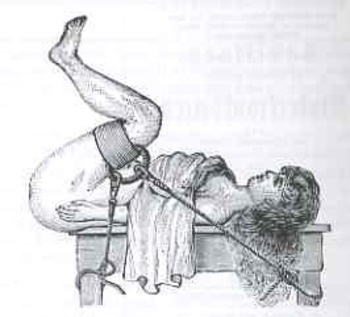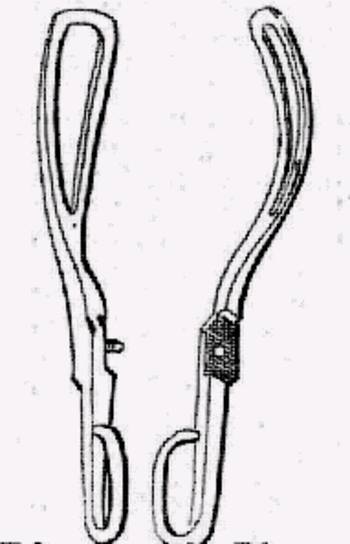JF Ptak Science Books Post 1501
Where does a device like the one, below, belong, exactly? Where in the long rolls of intellectual history should it be found?
E.A. Agerton is actually Ella C. Agerton--it was easy for me to assume that the person Agerton was a man, because to my experience when I find such devices in the patent office archives they are usually made by men. What Ms. Agerton was attempting with this device is something I don't understand, though she does make the following statement in her Patent Office record:
Here's another, earlier version of this beast, displayed in practical use. I have to say that the drawing of the woman's face is deeply disturbed:
I've also found quite by chance that the drawings of the faces of the women drawn as "patients" of these devices can be very unsettling, hardly faces at all, even though the representation of the rest of the body is functional. For example, the face of the woman below looks as though it is part of the furniture/device:
The drawings of faces can be so bad that I wonder if anyone can actually be that bad of an artist without trying to be.
None if this even reads comfortably; I don't know what it would have been like to been trussed up in such a thing.
 This leads to another uncomfortable image. At first glance I thought it was part of a delivery procedure, but it turns out that this was the rigging for a woman undergoing a gynecological examination. The woodcut appears in the first volume of Sammelband von 7 Kleinschriften zu gynakologischen Spezialthemen, 1858-1901, and more exactly in the contribution by Ludwig Neugebauer on an examination with a "speculum bivale l’ecarteur vaginal a trios branches…" published in 1884. I know that the prissy prejudices brought about with the coming of Queen Victoria in 1837 still had another 17 years to go at this point, which could explain why, perhaps, a doctor would want an aid in helping a woman maintain an examination position without him having to touch his patient, but, well, just look at the massiveness of the restraints! Also, the woman’s arms are *inside* the ropes—not down, not holding the ropes, but inside the binding, restrained. Either way, it isn’t good, treating the woman—in either case of pregnancy or obstetric examination—as the inferior vessel.
This leads to another uncomfortable image. At first glance I thought it was part of a delivery procedure, but it turns out that this was the rigging for a woman undergoing a gynecological examination. The woodcut appears in the first volume of Sammelband von 7 Kleinschriften zu gynakologischen Spezialthemen, 1858-1901, and more exactly in the contribution by Ludwig Neugebauer on an examination with a "speculum bivale l’ecarteur vaginal a trios branches…" published in 1884. I know that the prissy prejudices brought about with the coming of Queen Victoria in 1837 still had another 17 years to go at this point, which could explain why, perhaps, a doctor would want an aid in helping a woman maintain an examination position without him having to touch his patient, but, well, just look at the massiveness of the restraints! Also, the woman’s arms are *inside* the ropes—not down, not holding the ropes, but inside the binding, restrained. Either way, it isn’t good, treating the woman—in either case of pregnancy or obstetric examination—as the inferior vessel.
This is also part of a long history of the subjugation of women—the medical aspects of that indoctrination were perhaps somewhat more heinous than the social/legal/ethical/pedagogical/moral constituents. This illustration, even coming at the end of the Victorian era and approaching the dawn of encroaching bits of equality for (white) women, is a fair example of their subordinate status.
I just happened upon this picture during the course of my business day—a random image compiling these thoughts. If I were to try and choose another example of the medical aspect of the subjugation of woman I think that I would choose the story of the Chamberlen family. For several generations, beginning around 1680, this family of medical doctors practiced a secret—their secret—in delivering breeched babies. Breeched babies are those who were born feet first, which was usually a death sentence for both the child and the mother. Patriarch William Chamberlen invented a device that would greatly aid in delivering babies in this position—the forceps. And even though everyone today knows what these things are, the Chamberlens kept them a secret from the inquisitive medical world for more than a century. Their instrument was shrouded—literally!—in secret(s), used under cover, with ceremony, conveyed to the delivery area in a box and brought out with no witnesses. The Chamberlens felt their invention to be their own, for their own particular use and monetary gain, and the rest of the world be damned, and at least three generations (grandfather, father, son) kept the family secret. If their family could not be in charge of such a delivery then there would be no use of their extraordinary invention. This of course would save their income from being chipped away by other physicians or midwives or whatever competent person could be found to utilize the forceps—their economic gain coming at the cost of (savable but imperiled) pregnant women who would either pay the Chamberlens for aid in their breeched births or, well, probably die. To what degree this revolting behavior damaged other people can not be calculated. I’m not even sure about how to translate this into something more recognizable—would it be like Robert Koch keeping his isolation of Bacillus anthracis (1877), or tuberculosis bacillus (1882) a secret? Or Wilhelm Roentgen shrouding his discovery in secrecy somehow? (I know, I know, this is impossible.) Or isolating a secret, proprietary cure for cancer?
though everyone today knows what these things are, the Chamberlens kept them a secret from the inquisitive medical world for more than a century. Their instrument was shrouded—literally!—in secret(s), used under cover, with ceremony, conveyed to the delivery area in a box and brought out with no witnesses. The Chamberlens felt their invention to be their own, for their own particular use and monetary gain, and the rest of the world be damned, and at least three generations (grandfather, father, son) kept the family secret. If their family could not be in charge of such a delivery then there would be no use of their extraordinary invention. This of course would save their income from being chipped away by other physicians or midwives or whatever competent person could be found to utilize the forceps—their economic gain coming at the cost of (savable but imperiled) pregnant women who would either pay the Chamberlens for aid in their breeched births or, well, probably die. To what degree this revolting behavior damaged other people can not be calculated. I’m not even sure about how to translate this into something more recognizable—would it be like Robert Koch keeping his isolation of Bacillus anthracis (1877), or tuberculosis bacillus (1882) a secret? Or Wilhelm Roentgen shrouding his discovery in secrecy somehow? (I know, I know, this is impossible.) Or isolating a secret, proprietary cure for cancer?
There is a large part of me that believes that if the Chamerlens had figured out something like this that affected only men, a silver bullet for something or other, that their secret wouldn’t stayed a secret for 100 hours, let alone 100 years.



"Either way, it isn’t good ... This is also part of a long history of the subjugation of women"
Michel Foucalt's ideas seem very applicable. He argued that sadomasochism's adoption of trapppings of historical prisons, punishment and slavery reflected a similar behavioural subtext in "strategic power". Exactly the same could be argued about this excessive hardware used in gynaecological examination and childbirth; it suggests the designers' attitudes were very creepy. Cronenberg's "Dead Ringers" springs to mind.
Posted by: Ray Girvan | 04 June 2011 at 07:36 AM